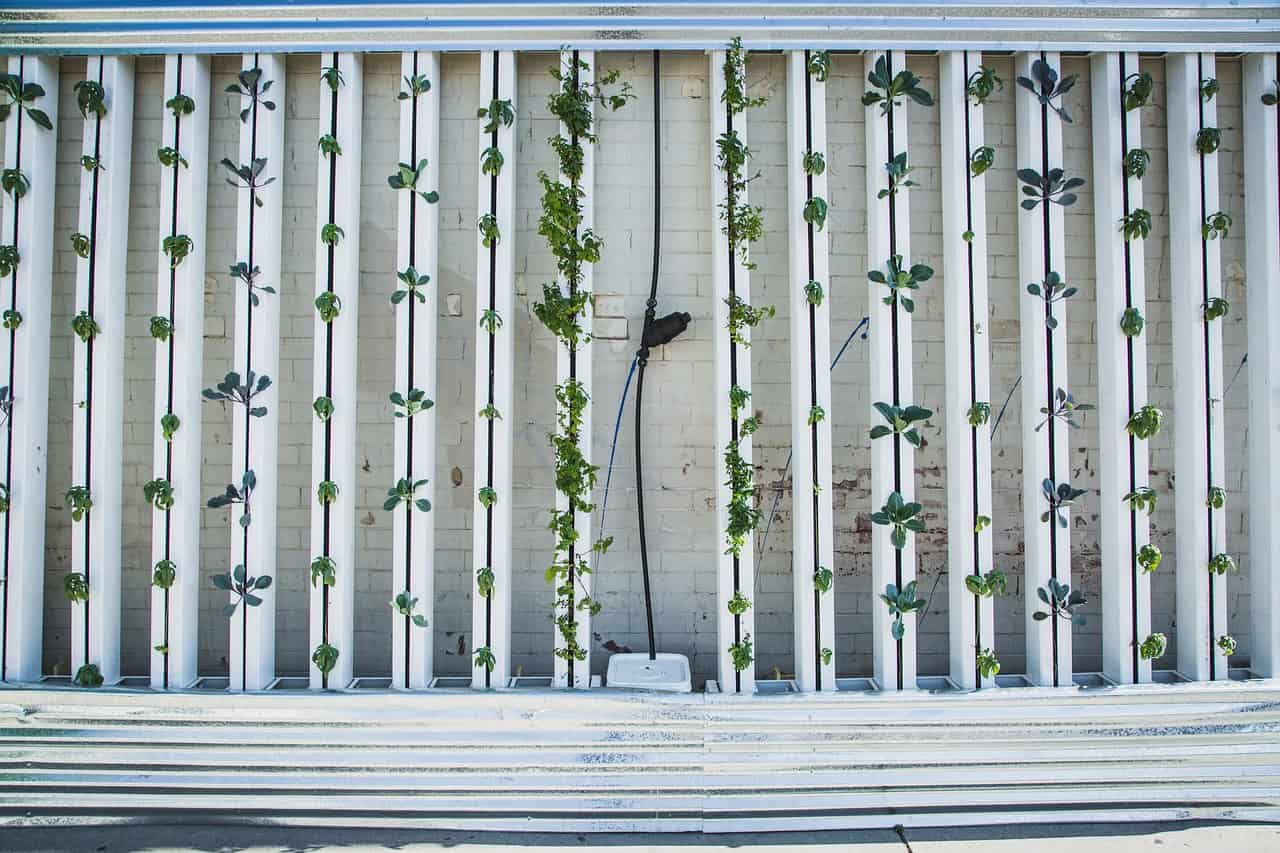Fast-growing with higher yields, growing hydroponic herbs has many advantages over traditional gardening. You can grow in elaborate hydroponics setups or with a simple hydroponics kit in your kitchen.
However big or small you want to go, many herbs grow very well with this soilless growth method. Herbs are an excellent choice for hydroponics due to their relatively small size, fast growth rate, and versatility in the kitchen. It’s a great way to begin if you are new to hydroponics. It’s also very satisfying to have a harvest in 30 – 40 days.
And if you’ve ever bought fresh herbs from the grocery store, you’ll know how convenient and cost-effective it can be to harvest your own fresh, fragrant leaves straight from your hydroponic system. (Fresh herbs are expensive at the grocery store! Oftentimes, they aren’t that fresh and are wilting.)
As far as the best herbs to grow hydroponically, basil, cilantro, mint, parsley, and chives claim the top spots. In these soil-free environments, herbs do more than just grow – they thrive!
I hope you keep reading to learn what there is to know about growing herbs in hydroponics. I’ve tried to outline it simply here. You’ll learn more about the best hydroponic herbs and why they are the best. I explain the different types of systems and outline the steps you need to begin. Then when you are done reading, you’ll know what to do.
Why Grow Hydroponic Herbs
Hydroponics is a type of gardening where plants grow in water that you supplement with nutrients. You can tailor each herb with it’s own nutritional requirements. Growing herbs in hydroponics has many advantages over soil gardening:
- Controlled environment
- Enhanced growth speed
- Space efficiency
- Soil-free: It’s clean and easy to manage
- Fewer pests and diseases: Hydroponic systems typically experience fewer issues
The ability to control every aspect of the growing environment means consistent, year-round growing, regardless of outdoor weather conditions.
Also, the advent of smart technology has been a game-changer in hydroponics. From automatic pH controllers to nutrient dosing systems, there are now devices that can automate much of the maintenance work, making hydroponics even easier and more efficient.
Hydroponics offers flexibility as you can set it up indoors or outdoors. It’s an excellent choice for urban gardeners who want fresh herbs regardless of their gardening space size.
Easy Herbs to Grow in Hydroponics
The easiest herbs to grow in hydroponics are basil, mint, parsley, chives, cilantro, and oregano. While many herbs are well-suited for hydroponic growth, these herbs stand out due to their adaptability, hardiness, and fast growth.
Parsley
Parsley is a hardy herb that does well in the consistent conditions provided by hydroponics. It’s great for beginners because of its resiliency. Hydroponic parsley thrives under the highly controlled conditions. It will grow thick and full delivering vibrant, nutrient-rich leaves for your soups, stews, or garnishes.
Mint
With its tendency to overtake garden beds in soil, growing mint hydroponically helps contain its rampant spread. Mint is easy to grow in hydroponics because it’s a water-loving plant. With regular pruning, it will quickly produce bountiful harvests perfect for tea, mojitos, salads, or lamb roast.
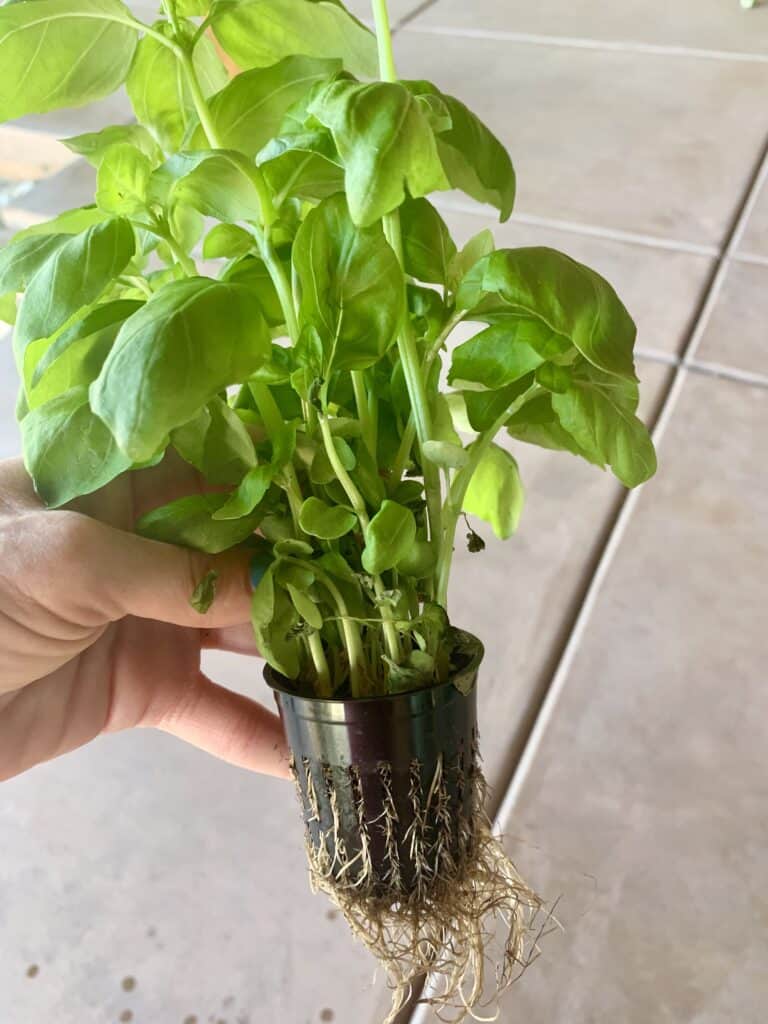
Basil
This aromatic herb is a hydroponic champion! Basil thrives in hydroponic systems due to its fast growth rate and its ability to flourish under constant moisture and nutrient supply conditions.
Basil is particularly well-suited to hydroponic cultivation. It’s a hydroponic favorite for beginners and those experienced with hydroponic gardening. Basil grows prolifically and provides fragrant leaves for your pesto and pasta dishes.
Cilantro / Coriander
Cilantro and coriander, with its relatively fast growth rate, makes it a good option for hydroponic setups. Known for its fast-growing nature, you’ll need to regularly harvest to promote new growth. Get ready to top your Mexican dishes with this tasty herb.
Chives
Chives are a resilient herb that can handle the constant water exposure of a hydroponic system. They’re low maintenance, require minimal light, and can grow year-round with the right setup. Soon you’ll be rewarded with mild, onion-flavored shoots for soups, dips, potatoes, meat, poultry, and more.
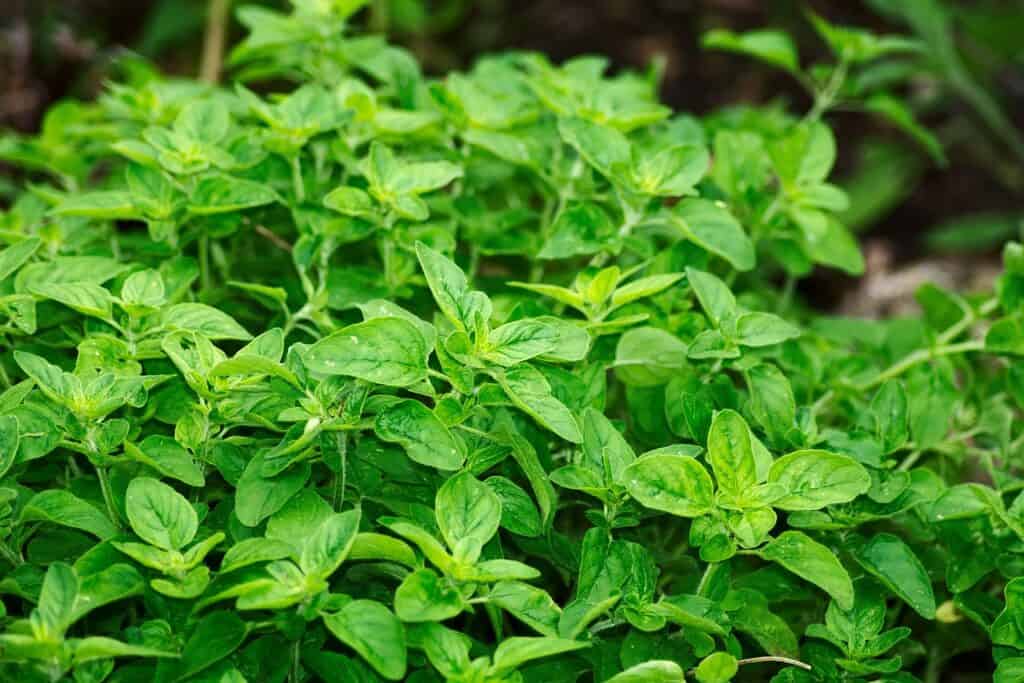
Oregano
Oregano is an easy hydroponics herb to grow. It grows well with consistent conditions that you control. Like with basil, you’ll have an abundant supply of leaves for your Italian dishes and more.
Marjoram
Marjoram is a popular herb in hydroponic cultivation. It thrives under ample light, growing to a manageable height of 8 to 10 inches. The plant occasionally produces small white or pink flower clusters, which you need to snip off so it doesn’t go to seed.
Marjoram has a subtle sweet flavor, a bit like balsam and less intense than its close relative, oregano. It’s great to use in meat, fish, and vegetable dishes.
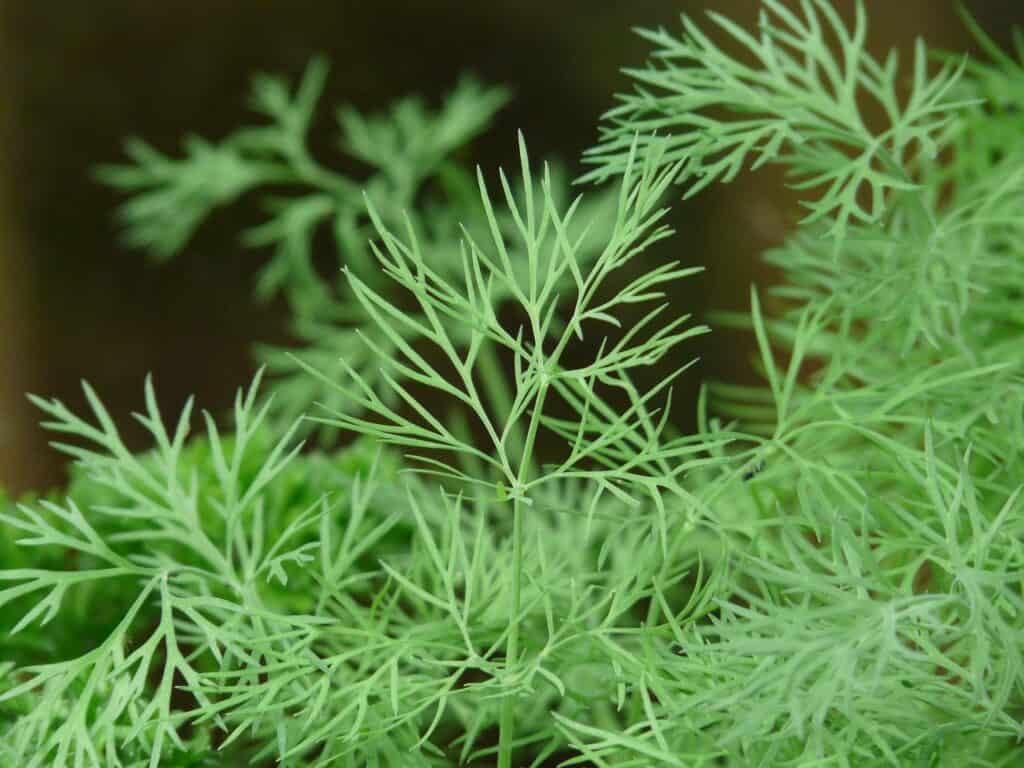
Dill
With its delicate, feathery leaves and unique flavor, dill is an herb that grows quickly. It’s relatively easy to care for in a hydroponic setup. The consistent nutrient delivery and controlled growing conditions of hydroponics allow dill to flourish, often leading to more robust growth compared to traditional soil-based methods.
Snip off as needed to use when making potato salad and other recipes. Young dill leaves tend to be milder in taste, so harvest according to your flavor preference. (I personally love growing dill because it’s really hard to find dried dill in my grocery store. Fresh dill, like all fresh herbs, are very expensive.)
Watercress
Watercress (Nasturtium officinale) is in the mustard family. It is a semi-aquatic plant with a spicy kick, is ideally suited to hydroponic systems. Its preference for wet environments aligns with the consistent water and nutrient delivery of hydroponics, leading to lush, vigorous growth.
For harvesting watercress, it’s best to clip off the leafy stems just above the water level, which ensures the plant continues to grow for future harvests. This crisp, peppery herb is a delicious addition to salads, sandwiches, and soups, providing a fresh punch of flavor when used directly after harvesting. Yum!
Thyme
Thyme (Thymus vulgaris) is hardy and grows steadily in different hydroponic mediums. You’ll love snipping off thyme to use in your recipes, including meats, soups, sauces, vegetables, pizza, pasta, and more. It smells wonderful too!
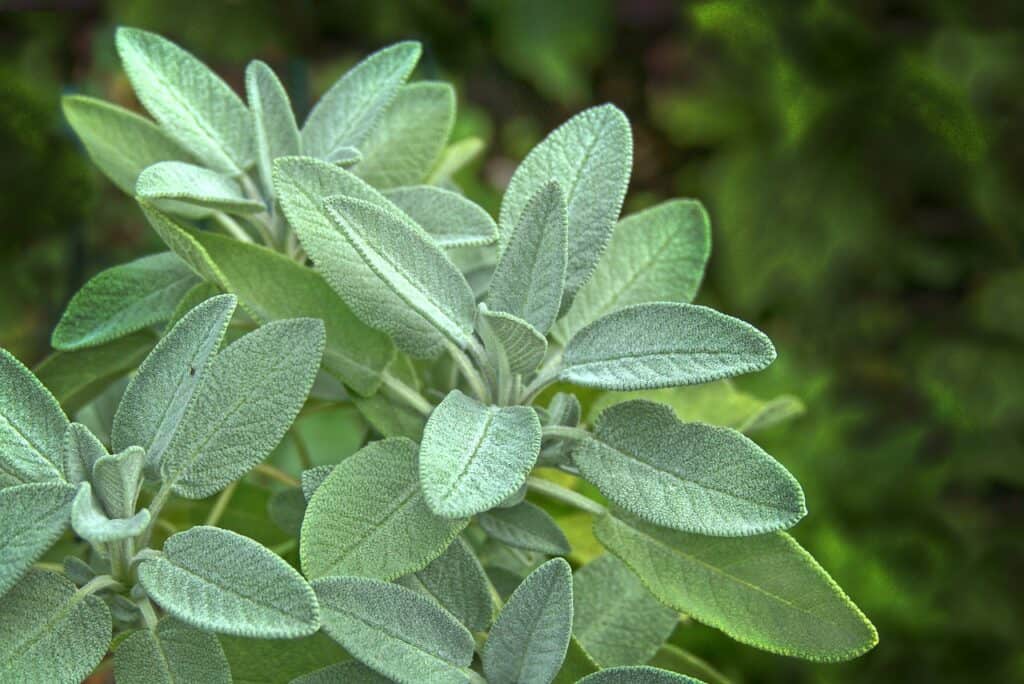
Sage
Sage (Salvia officinalis) is well-suited for hydroponic growing because it does well with a consistent nutrient supply and slightly alkaline pH levels, which you can control
Lemongrass
Lemongrass (Cymbopogon citratus) is a citrusy herb that germinates quickly and is easy to establish. While it’s not typically thought of as often as popular hydroponic herbs like basil and mint, it grows well with hydroponic nutrients.
Once it really starts taking off, you’ll need to prune it so it doesn’t grow too large. It will be handy to have your own fresh supply of lemongrass for Asian dishes, soups, sauces, tea, and more.
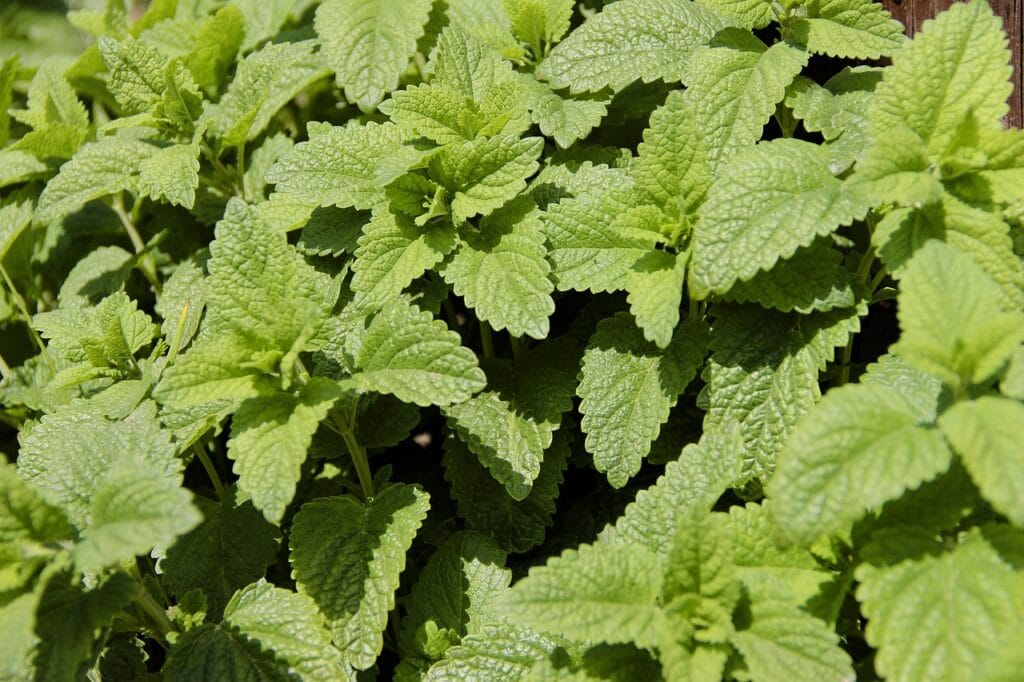
Lemon balm
Lemon balm (Melissa officinalis) is an herb from the mint family. It’s an herb that grows well in hydroponics because it prefers consistent moisture levels. It grows compactly so you can space it in hydroponics setups, and it won’t compete excessively for light. Lemon balm grows relatively quickly which you can enhance in hydroponics gardening to maximize yield.
Why Do Some Plants Grow Better in Hydroponics than Others?
In hydroponic systems, plants are grown in containers filled with inert materials like perlite, vermiculite, or coconut coir, which support the roots. These plants obtain all essential nutrients from an oxygenated water solution.
While hydroponics is suitable for a variety of plants, including leafy greens, herbs, fruits, and vegetables, some plants thrive better due to their specific nutrient and environmental needs. Plants needing high oxygen levels at the root zone, such as lettuce, spinach, and other leafy greens, are particularly well-suited for hydroponic growth.
Herbs That Don’t Grow Well in Hydroponics
While many herbs thrive in hydroponic conditions, some struggle due to the lack of soil, poor adaptability to water culture, or need for specific growing conditions.
Rosemary, for example, prefers a well-drained, somewhat dry soil and might struggle in a hydroponic system. Lavender, another Mediterranean herb like rosemary, may also struggle because it prefers dry conditions.
While many herbs thrive in hydroponic systems, some are not ideally suited to these conditions due to their specific growing requirements or characteristics. So know that you CAN grow these herbs hydroponically — especially if you like a challenge! — but there are others that are better to grow.
These herbs may require a bit more care, the right hydroponic system, and some modifications to their growing environment. Here are some types of herbs that might pose challenges when grown hydroponically:
Woody herbs
Woody herbs like rosemary and lavender can be more difficult to grow in hydroponics systems. They prefer well-drained conditions and may rot if their roots are too wet for too long. However, with the right care and a suitable system (like aeroponics or ebb and flow), it is possible to grow these herbs hydroponically.
Perennial herbs
Perennial herbs, which have a lifespan of more than two years, may not be the best choice for hydroponic systems. This is primarily due to their need for a dormancy period, which can be challenging to replicate in a hydroponic setup.
Large, bushy herbs
Herbs that grow into large bushes, such as some types of sage, might not be the best fit for hydroponic systems, particularly if space is limited. These plants can become too large for many home hydroponic systems. Basil can grow large and bushy as well but harvesting the leaves regularly will keep it manageable.
Deep-rooted herbs
Herbs with long taproots, like comfrey, can be a challenge to grow in hydroponics because they may need more root space than what is typically available in hydroponic systems.
Horseradish
Yes, this root is classified as an herb! Horseradish is another deep-rooted herb that’s not as suitable for hydroponics as other herbs. It’s traditionally grown for its large root, which can be challenging in hydroponic systems that generally accommodate smaller, fibrous root systems.
Growing Herbs Hydroponically Indoors
Growing herbs hydroponically indoors provides a versatile and efficient method to cultivate fresh, flavorful herbs year-round, irrespective of the weather or outdoor conditions.
Additionally, indoor hydroponic gardening can save space and water, making it a sustainable choice for urban dwellers or those with limited outdoor gardening space.
If you are opting for a more traditional (aka larger) hydroponics setup, you can set it up indoors in a greenhouse, garage, or shed. As long as you can set up lighting (may or may not need in a greenhouse), you can grow herbs indoors with hydroponics.
What is Hydroponics
Hydroponics is a method of growing plants in a water-based, nutrient-rich solution, rather than soil. The plant’s roots are exposed directly to this nutrient solution, allowing them to take in what they need without having to compete with other soil-dwelling organisms. Many systems rely on grow lights instead of the sun.
Hydroponic gardening offers numerous benefits. It uses significantly less water than traditional gardening. There are fewer issues with diseases and pests. Plants can be grown closer together, even vertically. It’s an excellent space-saving solution. You control the nutrient requirements for each plant which makes it thrive.
How to Grow Hydroponic Herbs
If you’re ready to dip your toes (or rather, your plants’ roots) into the world of hydroponics, here are the basic steps you need to follow. It requires a bit of setup and regular maintenance, but the rewards are well worth it. You’ll enjoy fresh, home-grown herbs year-round, all without any soil!
Step 1: Choose the hydroponic system
There are numerous types of hydroponic systems available, including Wick, Deep Water Culture (DWC), Nutrient Film Technique (NFT), Ebb and Flow, Drip System, and Aeroponics.
For beginners, the DWC or the Wick System are often the simplest to set up and manage. Your choice will depend on your resources, available space, and the specific needs of the herbs you plan to grow. Also factor in what seems manageable and doable for you.
Step 2: Choose the herbs
Decide which herbs you want to grow. Fast-growing, water-loving herbs like basil, mint, chives, and parsley are usually excellent choices for hydroponics. Always consider your personal preferences, the specific needs of the herbs, and how much space and light you can provide.
Step 3: Setup the system
After choosing a system, set it up according to its specifications. This typically involves assembling the structure, setting up any necessary water and air pumps, and preparing the nutrient solution.
Step 4: Start the seeds or seedlings
You can start your hydroponic garden with seeds or purchase seedlings (small plants that have already started growing) from a nursery.
If you’re starting with seeds, plant them in a rockwool starter plug or similar medium and place them in a propagator until they germinate. Once the seedlings have developed a few leaves, you can move them to the hydroponic system.
Step 5: Prepare the nutrient solution
Plants need certain nutrients to grow, which they usually get from the soil. In hydroponics, you’ll need to provide these nutrients in the water. You can purchase ready-made hydroponic nutrient solutions and add them to your system according to the manufacturer’s instructions. Learn about the best hydroponic nutrients.
Step 6: Monitor the pH
The pH level of your nutrient solution can affect how well your herbs can absorb the nutrients they need. Most herbs prefer a slightly acidic environment. Regularly check the pH of your solution using a pH meter, and aim to keep it between 5.5 and 6.5. This is the ideal pH for nutrient absorption in most herbs. There automatic systems available that will regularly test the pH level, saving you time.
Step 7: Provide light
Most herbs need plenty of light to grow. If you’re growing indoors and don’t have access to abundant natural light, you’ll need to provide supplemental, artificial light. LED grow lights are energy-efficient and ideal for this purpose. Most herbs require around 10 – 14 hours of direct light per day.
Be sure plants get the light they need and that a larger plant doesn’t block light from smaller plants.
Step 8: Monitor and maintain
This will be fun to do, especially when you are new to hydroponic growing. Check your plants daily for signs of pests or disease. Also, observe the color and firmness of the leaves (yellow, brown, droopy, etc.) and the overall growth rate, as these can indicate if your plants are getting the nutrients they need.
Adjust the nutrient solution, pH, or lighting as needed. Remember to change your nutrient solution regularly – at least every two weeks is a good rule of thumb.
Step 9: Get ready to harvest!
The fun part! Fresh herbs for the snipping! Hopefully you’ve already been enjoying their heavenly scents. Now it’s time to savor them for your foods and drinks. Once your herbs are established, you can start harvesting.
Always use a sharp, clean tool (I use kitchen scissors) to cut the stems to avoid damaging the plants or spreading disease. Never harvest more than one-third of any plant at a time.
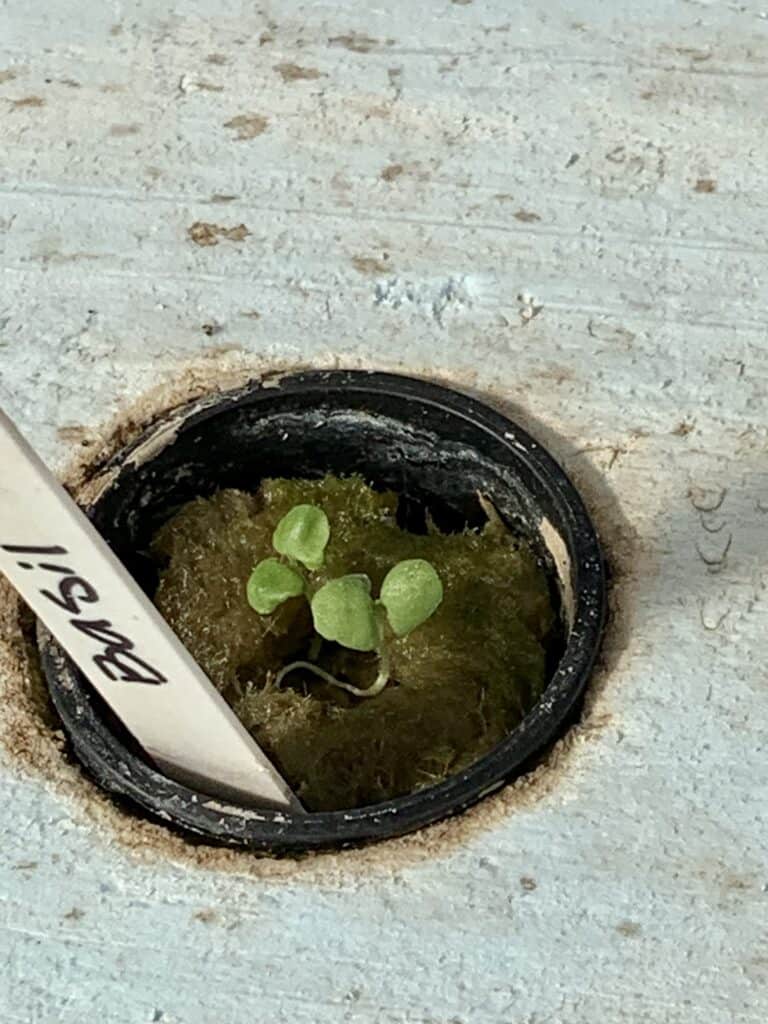
How to Grow Herbs in Hydroponics Successfully
Each herb has specific growing requirements, so it’s important to understand the needs of each plant in terms of nutrients, pH level, light, and temperature to have a successful hydroponic herb garden.
While there are certain herbs that may pose challenges when grown in hydroponic systems, it’s worth noting that successful hydroponic gardening often goes beyond just choosing the right plants.
Numerous factors come into play that can influence the overall health and productivity of your hydroponic herb garden, regardless of the specific herbs you’re growing. Here’s what you’ll need to consider:
Nutrient requirements
Different herbs have different nutrient requirements. Meeting these needs is critical for your plants’ health and productivity. A balanced hydroponic nutrient solution typically contains essential macronutrients (nitrogen, phosphorus, potassium, calcium, magnesium, and sulfur) and micronutrients (iron, manganese, zinc, copper, molybdenum, and boron).
Some herbs may require more of certain nutrients than others, so you might need to adjust your nutrient solution based on the specific herbs you’re growing.
Lighting
Herbs need plenty of light for photosynthesis. If you’re growing herbs indoors, you’ll need to provide supplemental lighting. LED grow lights are an energy-efficient option that can provide the full spectrum of light that plants need. The amount of light your herbs need can vary, but most require a minimum of 10 – 12+ hours of light per day.
Temperature and humidity
Most herbs prefer temperatures between 65 – 75°F (18-24°C), but some like it cooler or warmer. Similarly, while most herbs do well in a fairly humid environment, others prefer drier conditions. You will learn to monitor the temperature and humidity in your growing area and try to maintain optimal conditions for your specific plants.
Pest and disease management
Even though hydroponic systems generally have fewer pest and disease problems than soil-based gardens, you’ll still need to keep an eye out for any potential issues. Regularly inspect your plants for signs of pests or disease, and treat any problems promptly to prevent them from spreading.
Remember…
Don’t be discouraged if you face challenges when you first start growing herbs hydroponically. With a bit of patience and practice, you’ll learn more about your plants and how to provide the best conditions for them to thrive. Hydroponic herb gardening can be a fun and rewarding hobby, and there’s always something new to learn!
Tips for Growing Hydroponic Herbs
Master the nutrients
Hydroponic herb gardening is a nuanced practice, with different herbs requiring distinct nutrient profiles for optimal growth. Plants are reliant on the nutrient solution to meet all their nutritional needs, unlike in soil where some nutrients are naturally present. Therefore, it’s crucial to adjust and balance the nutrient solution to suit the specific requirements of each herb.
For instance, basil thrives with higher levels of nitrogen, while dill prefers a balanced mix of nitrogen, phosphorus, and potassium. Thyme requires a lean nutrient regimen, with relatively lower levels of nutrients compared to most other herbs. You will learn more when you begin growing herbs.
Mastering these differing nutrient needs is an essential part of achieving success with hydroponic herb gardening. It allows you to maximize the growth and yield of each herb variety while ensuring their health and vitality.
Pruning and harvesting
Regular pruning encourages bushier growth and helps keep plants healthy. Always use clean, sharp scissors or pruning shears to avoid spreading disease. When harvesting, never remove more than one-third of the plant at a time to avoid stressing it.
Preventing pests and diseases
While hydroponic systems typically have fewer pest and disease issues than soil-based gardens, problems can still arise. If you spot pests, consider using organic insecticidal soaps or introducing beneficial insects. For diseases, proper plant spacing, adequate ventilation, and regular cleaning of your system can prevent most issues.
Go vertical
If space is a premium, consider vertical hydroponic systems. They allow you to grow more herbs in a smaller area and can be a great solution for urban or apartment living.
Hydroponic Herbs: Troubleshooting Tips
As you embark on your hydroponic herb journey, you might encounter a few challenges. Here are some common problems and potential solutions:
1. Nutrient deficiency or toxicity
If your plants’ leaves are turning yellow or brown, or if growth seems stunted, you might be dealing with nutrient problems. Check your nutrient solution concentration and pH level – you may need to adjust them. If issues persist, flush your system with clean water and then add a fresh batch of nutrient solution.
2. Poor growth despite good conditions
If your plants aren’t thriving despite correct nutrient and pH levels, consider your lighting. Are your plants getting enough light, but not too much? Also, check the temperature. Most herbs prefer cooler conditions, ideally between 65 to 75 degrees Fahrenheit.
3. Algae growth
Algae love nutrient-rich, humid environments, so they can sometimes be a problem in hydroponic systems. If you notice algae, it could be due to light exposure. Cover your system and nutrient solution to limit light exposure. Regularly cleaning your system can also help to prevent algae buildup.
4. Root rot
This can occur when the water temperature is too high, or oxygen levels are too low. Keep your water temperature under control, ideally between 65 to 70 degrees Fahrenheit, and consider adding an air stone or additional air pump to increase oxygenation.
Root rot is one reason rosemary doesn’t thrive in hydroponics. It doesn’t like wet feet.
Choosing a Hydroponic System
Understanding different types of hydroponics can help you make informed decisions about which system best suits your space, budget, and the particular herbs you plan to grow.
Each system has its strengths and weaknesses, and understanding these nuances can make a difference in the success of your hydroponic garden. Here’s a rundown on the most popular hydroponic systems:
1. Wick System:
This is the simplest type of hydroponic system. It uses a wick to draw nutrient-rich water from a reservoir to the plant roots. The Wick System is passive, meaning it doesn’t require a pump or electricity. It’s ideal for small, water-loving herbs like mint and chives, but may not provide enough hydration for larger, more water-demanding plants.
2. Deep Water Culture (DWC):
DWC involves suspending plants in a nutrient solution with their roots directly in the water. An air pump supplies oxygen to the roots. This system is excellent for fast-growing, water-loving herbs such as lettuce and basil. However, it might not be suitable for herbs preferring drier conditions, like rosemary or thyme.
3. Nutrient Film Technique (NFT):
In NFT systems, a thin film of nutrient solution constantly flows over the roots, providing them with nutrients, water, and oxygen. This system is great for many types of herbs, including basil, mint, and parsley.
However, it relies heavily on the pump – if it fails, plant roots can dry out quickly. Having a backup generator may be important, depending on the size of your setup.
4. Ebb and Flow (Flood and Drain):
This system works by flooding the plant root area with a nutrient solution at specific intervals and then letting it drain back into the reservoir. An Ebb and Flow systems is quite versatile and can support a variety of herbs, but it requires careful timing to avoid over- or under-watering.
5. Drip System:
In a Drip System, a timer controls a water pump, which drips nutrient solution onto the plant roots. This system can be highly efficient and allows a lot of control over watering schedule and nutrient supply. It works well with most herbs but may require more maintenance to prevent clogging in the drip emitters.
6. Aeroponics:
Probably the most high-tech of the hydroponic methods, aeroponics involves misting plant roots with a nutrient solution while they hang in the air. This method offers excellent oxygenation but can be more challenging to manage due to the precise control it requires. Herbs that do well in an aeroponic system include basil, cilantro, and chives.
Choosing a Hydroponic System for Growing Herbs
The best hydroponic system for your herbs depends largely on their specific needs and your own resources, including budget, space, and time. In general, fast-growing, water-loving herbs like basil, mint, parsley, and chives can thrive in most types of hydroponic systems.
For larger or more demanding herbs, such as rosemary or lavender, you might have better luck with a Drip System or Ebb and Flow system that allows for greater control over watering and nutrient supply.
Each hydroponic system requires different levels of attention, maintenance, and investment. Starting small with a Wick System or DWC can be a good way to understand hydroponics basics before moving onto more complex systems like Aeroponics or NFT.
Growing hydroponic herbs is as much an art as it is a science, requiring observation, adjustment, and a dash of green-thumb intuition. But with a little patience and practice, you’ll soon be on your way to a lush, fragrant harvest, no soil required!
What is a Hydroponic Herb Garden
A hydroponic herb garden is a soil-less growing system where herbs are cultivated in a water-based, nutrient-rich solution. In this setup, the roots come into direct contact with the nutrient solution while also having access to oxygen, crucial for growth.
It offers a controlled environment that maximizes the growth potential of the herbs by providing them with the exact nutrients, water, and light they need.
This allows for year-round indoor gardening, regardless of outdoor weather conditions, leading to faster growth rates and higher yields than traditional soil gardening.
FAQs
Are hydroponic herb gardens worth it?
Yes, hydroponic herb gardens are worth it. They allow for year-round indoor or outdoor gardening. Plants grow faster and have higher yields. They also require less space and water than traditional soil gardening. It’s a great way to grow fresh herbs.
Which herbs grow best hydroponically?
The herbs that grow best hydroponically are typically fast-growing and water-loving varieties. These include basil, mint, chives, cilantro, chives, oregano, and parsley. They thrive in hydroponic systems due to their preference for consistent moisture and nutrient availability.
Do herbs do well in hydroponics?
Yes, many herbs grow very well in hydroponics. Hydroponic systems provide a controlled environment that allows herbs to receive the exact nutrients, light, and water they need for optimal growth. Each herb has specific needs, so you can cater to each plant’s requirements, maximizing its growth.
What is the best way to grow herbs in hydroponics?
The best way to grow herbs in hydroponics involves selecting the right system for your herbs; using a quality nutrient solution; maintaining the correct pH level; providing ample light (typically 10+ hours daily); and monitoring and maintaining your system. Start by choosing herbs that are well-suited to hydroponic growing, like basil or mint, and consider a beginner-friendly system such as Deep Water Culture or a Wick System.
What herbs can be grown hydroponically?
Lots of herbs can be grown hydroponically, including basil, mint, parsley, chives, dill, cilantro, oregano, and thyme. These herbs are popular for hydroponics due to their suitability to the moist, nutrient-rich conditions.
Do herbs grow well hydroponically?
Yes, many herbs grow well hydroponically. Hydroponic systems provide a controlled environment, ensuring consistent access to water, nutrients, and light, which contribute to the optimal growth of herbs.
What herbs grow fast for hydroponics?
Fast-growing herbs ideal for hydroponics include basil, dill, cilantro, and mint. These herbs have quick growth rates and adapt well to the constant moisture and nutrient availability in hydroponic systems. They are excellent choices for beginners and people looking for quick harvests.
What leafy herbs for hydroponics?
Leafy herbs suitable for hydroponics include basil, mint, parsley, and cilantro. These plants thrive in hydroponic systems due to their preference for moisture and the high nutrient absorption rates they can achieve, leading to lush, healthy foliage.
What herbs grow well together in hydroponics?
Many herbs grow well together in hydroponics, including basil, chives, parsley, and dill. These herbs have similar water and nutrient needs, making them compatible in a shared hydroponic system. Growing herbs together can also maximize space usage and provide a variety of flavors for your cooking.
Growing Hydroponic Herbs
Hydroponic herb growing is an exciting adventure for any gardening enthusiast. It lets us grow a wide range of herbs in our own home, free from the usual limits of traditional soil-based gardening. The secret lies in creating the perfect conditions for each herb and making sure you meet their unique needs.
If you’re an experienced gardener looking for a new project or a newbie wanting to start your own sustainable indoor garden, hydroponic herbs are a fantastic route to take. Sure, it might take a little getting used to, but with some patience, careful observation, and a genuine love for learning, it’s a journey that’s totally worth it. Plus, there’s nothing quite like the satisfaction of using home-grown, hydroponic herbs in your favorite dishes.
In addition to growing herbs, learn more about hydroponic growing:
- Best hydroponic plants
- Best hydroponic fruit to grow
- Hydroponics vs Soil: Which Is Better?
Featured image credit: BrightAgrotech from Pixabay

